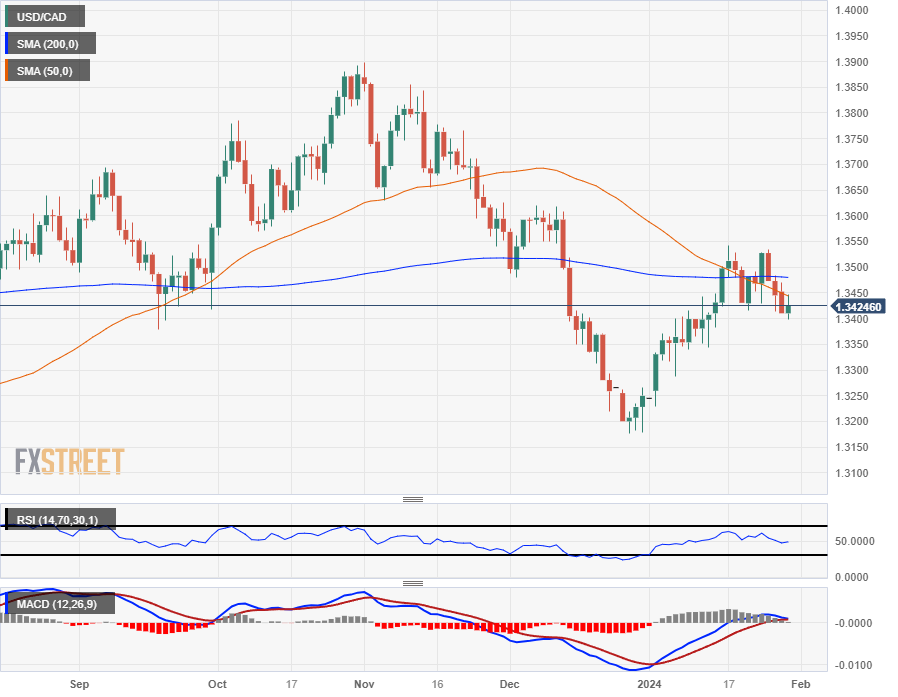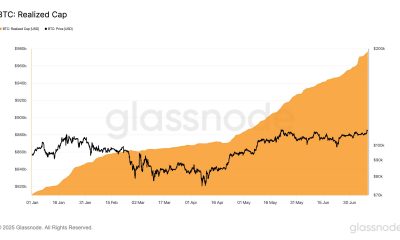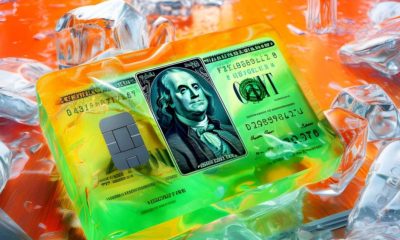

others
Canadian Dollar trims back from Tuesday highs after markets pivot into Greenback – Crypto News
- Canadian Dollar pares back recent gains, but price action remains nearby.
- Canada sees GDP figures on Wednesday, Manufacturing PMI on Thursday.
- US JOLTS beat trims rate cut bets ahead of Wednesday’s FOMC policy statement.
The Canadian Dollar (CAD) shed some points on Tuesday after a moderate data-beat for December’s US JOLTS Job Openings pushed investors back into the US Dollar (USD).
Canada brings November’s Gross Domestic Product (GDP) figures on Wednesday, which will be followed by the Canadian S&P Global Manufacturing Purchasing Managers Index (PMI) data on Thursday.
The broad market focus this week continues to be Wednesday’s US Federal Reserve (Fed) rate call. Friday brings another print for the US Nonfarm Payrolls (NFP).
Daily digest market movers: Canadian Dollar pulls back from near-term highs
- Canadian Dollar is largely mixed on Tuesday but moderately down against Tuesday’s top performers in the US Dollar and the Euro (EUR).
- US JOLTS Job Openings in December came in at 9.026 million versus the expected decline to 8.75 million from November’s 8.925 million (revised from 8.79 million).
- Initial prints in US labor figures continue to see revisions on an ongoing basis, JOLTS has been revised every month since at least October 2013.
- JOLTS data to see further adjustments from March 6 when the Bureau of Labor Statistics (BLS) incorporates annual updates to current employment statistics as seasonal adjustment factors.
- JOLTS print pushes rate cut expectations further down, rate swaps now see 62% chance of no rate cut from the Fed in March, 17% chance of no rate move in April, according to CME’s FedWatch Tool.
- Investors will be looking for a firmer pivot from Fed Chairman Jerome Powell on Wednesday.
- Fed Monetary Policy Statement slated for 19:00 GMT Wednesday, Federal Open Market Committee (FOMC) Press Conference scheduled for 30 minutes later.
- Canadian GDP forecast to tick up slightly from 0.0% to 0.1% in November.
- Friday’s US NFP forecast to slip to 180K in January from December’s 216K.
Canadian Dollar price today
The table below shows the percentage change of Canadian Dollar (CAD) against listed major currencies today. Canadian Dollar was the weakest against the Euro.
| USD | EUR | GBP | CAD | AUD | JPY | NZD | CHF | |
| USD | -0.06% | 0.40% | 0.11% | 0.44% | 0.26% | 0.31% | 0.24% | |
| EUR | 0.06% | 0.46% | 0.18% | 0.51% | 0.32% | 0.37% | 0.30% | |
| GBP | -0.40% | -0.45% | -0.28% | 0.05% | -0.13% | -0.09% | -0.15% | |
| CAD | -0.10% | -0.15% | 0.30% | 0.33% | 0.16% | 0.21% | 0.14% | |
| AUD | -0.43% | -0.49% | -0.03% | -0.32% | -0.18% | -0.12% | -0.18% | |
| JPY | -0.25% | -0.30% | 0.15% | -0.14% | 0.16% | 0.06% | -0.02% | |
| NZD | -0.29% | -0.35% | 0.10% | -0.18% | 0.15% | -0.03% | 0.01% | |
| CHF | -0.24% | -0.30% | 0.15% | -0.12% | 0.21% | 0.03% | 0.06% |
The heat map shows percentage changes of major currencies against each other. The base currency is picked from the left column, while the quote currency is picked from the top row. For example, if you pick the Euro from the left column and move along the horizontal line to the Japanese Yen, the percentage change displayed in the box will represent EUR (base)/JPY (quote).
Technical Analysis: Canadian Dollar pulls back from recent highs against US Dollar
The Canadian Dollar (CAD) is moderating on Tuesday, gaining a quarter to a third of a percent against the Pound Sterling (GBP) and the Australian Dollar (AUD), while declining around a sixth of a percent against the US Dollar and the Euro.
The USD/CAD tested into the low side at the 1.3400 handle early Tuesday before a Greenback rally made up for near-term losses as USD/CAD splashes around the familiar 1.3430 level.
USD/CAD continues to drift into the low side as the pair grapples with a bearish crossover of the 50-day and 200-day Simple Moving Averages (SMA), pricing in a near-term technical ceiling near the 1.3500 handle.
A continued drag down will see the USD/CAD crack through 1.3400 to make a fresh run at the last swing low near December’s bottom bid of 1.3177.
USD/CAD hourly chart
USD/CAD daily chart
Fed FAQs
Monetary policy in the US is shaped by the Federal Reserve (Fed). The Fed has two mandates: to achieve price stability and foster full employment. Its primary tool to achieve these goals is by adjusting interest rates.
When prices are rising too quickly and inflation is above the Fed’s 2% target, it raises interest rates, increasing borrowing costs throughout the economy. This results in a stronger US Dollar (USD) as it makes the US a more attractive place for international investors to park their money.
When inflation falls below 2% or the Unemployment Rate is too high, the Fed may lower interest rates to encourage borrowing, which weighs on the Greenback.
The Federal Reserve (Fed) holds eight policy meetings a year, where the Federal Open Market Committee (FOMC) assesses economic conditions and makes monetary policy decisions.
The FOMC is attended by twelve Fed officials – the seven members of the Board of Governors, the president of the Federal Reserve Bank of New York, and four of the remaining eleven regional Reserve Bank presidents, who serve one-year terms on a rotating basis.
In extreme situations, the Federal Reserve may resort to a policy named Quantitative Easing (QE). QE is the process by which the Fed substantially increases the flow of credit in a stuck financial system.
It is a non-standard policy measure used during crises or when inflation is extremely low. It was the Fed’s weapon of choice during the Great Financial Crisis in 2008. It involves the Fed printing more Dollars and using them to buy high grade bonds from financial institutions. QE usually weakens the US Dollar.
Quantitative tightening (QT) is the reverse process of QE, whereby the Federal Reserve stops buying bonds from financial institutions and does not reinvest the principal from the bonds it holds maturing, to purchase new bonds. It is usually positive for the value of the US Dollar.
-
![DIS Elliott Wave technical analysis [Video]](https://dripp.zone/news/wp-content/uploads/2025/06/DIS-Elliott-Wave-technical-analysis-Video-Crypto-News-400x240.jpg)
![DIS Elliott Wave technical analysis [Video]](https://dripp.zone/news/wp-content/uploads/2025/06/DIS-Elliott-Wave-technical-analysis-Video-Crypto-News-80x80.jpg) others1 week ago
others1 week agoSkies are clearing for Delta as stock soars 13% on earnings beat – Crypto News
-
![DIS Elliott Wave technical analysis [Video]](https://dripp.zone/news/wp-content/uploads/2025/06/DIS-Elliott-Wave-technical-analysis-Video-Crypto-News-400x240.jpg)
![DIS Elliott Wave technical analysis [Video]](https://dripp.zone/news/wp-content/uploads/2025/06/DIS-Elliott-Wave-technical-analysis-Video-Crypto-News-80x80.jpg) others1 week ago
others1 week agoSkies are clearing for Delta as stock soars 13% on earnings beat – Crypto News
-

 Cryptocurrency6 days ago
Cryptocurrency6 days agoWhale Sells $407K TRUMP, Loses $1.37M in Exit – Crypto News
-
Technology1 week ago
XRP Eyes $3 Breakout Amid Rising BlackRock ETF Speculation – Crypto News
-
Technology1 week ago
Breaking: SharpLink Purchases 10,000 ETH from Ethereum Foundation, SBET Stock Up 7% – Crypto News
-

 Blockchain1 week ago
Blockchain1 week agoBitcoin Hits All-Time High as Crypto Legislation Votes Near – Crypto News
-
Business1 week ago
PENGU Rallies Over 20% Amid Coinbase’s Pudgy Penguins PFP Frenzy – Crypto News
-

 Blockchain7 days ago
Blockchain7 days agoRobinhood Dealing With Fallout of Tokenized Equities Offering – Crypto News
-

 Cryptocurrency6 days ago
Cryptocurrency6 days agoSatoshi-Era Bitcoin Whale Moves Another $2.42 Billion, What’s Happening? – Crypto News
-

 Metaverse1 week ago
Metaverse1 week agoHow Brands Can Deepen Customer Connections in the Metaverse – Crypto News
-

 Technology1 week ago
Technology1 week agoPerplexity launches Comet, an AI-powered browser to challenge Google Chrome; OpenAI expected to enter the space soon – Crypto News
-

 Cryptocurrency1 week ago
Cryptocurrency1 week agoBitcoin Breaks New Record at $111K, What’s Fueling the $120K Price Target? – Crypto News
-

 others1 week ago
others1 week agoEUR/GBP climbs as weak UK data fuels BoE rate cut speculation – Crypto News
-

 Blockchain1 week ago
Blockchain1 week agoSUI Chart Pattern Confirmation Sets $3.89 Price Target – Crypto News
-
Business1 week ago
US Senate To Release CLARITY Act Draft Next Week – Crypto News
-

 others1 week ago
others1 week ago$687,220,000 in Bitcoin Shorts Liquidated in Just One Hour As BTC Explodes To $116,000 – Crypto News
-

 Business1 week ago
Business1 week agoS&P Global Downgrades Saks Global’s Credit Rating – Crypto News
-

 others1 week ago
others1 week agoAnthony Scaramucci Says $180,000 Bitcoin Price Explosion Possible As BTC ‘Supremacy’ Creeps Up – Here’s His Timeline – Crypto News
-

 Cryptocurrency1 week ago
Cryptocurrency1 week agoBitcoin Breaks New Record at $111K, What’s Fueling the $120K Price Target? – Crypto News
-
Technology4 days ago
Fed Rate Cut Odds Surge As Powell’s Future Hangs In The Balance – Crypto News
-
Business1 week ago
Breaking: US SEC Delays Grayscale Avalanche ETF Launch – Crypto News
-

 De-fi1 week ago
De-fi1 week agoOusted Movement Labs Co-Founder Sues Startup in Delaware Court – Crypto News
-
Business1 week ago
XRP Set for Big Week as ProShares ETF Launches July 18 – Crypto News
-
Technology4 days ago
Fed Rate Cut Odds Surge As Powell’s Future Hangs In The Balance – Crypto News
-

 Technology1 week ago
Technology1 week agoOne Tech Tip: Click-to-cancel is over, but there are other ways to unsubscribe – Crypto News
-

 Technology1 week ago
Technology1 week agoGoogle DeepMind hires Windsurf CEO as OpenAI’s $3 billion acquisition collapses – Crypto News
-
Technology1 week ago
Hyperliquid Hits Record $10.6B OI As HYPE Price Records New ATH – Crypto News
-

 Blockchain1 week ago
Blockchain1 week agoZiglu Faces $2.7M Shortfall as Crypto Fintech Enters Special Administration – Crypto News
-
Cryptocurrency7 days ago
Why Is Bitcoin Up Today? – Crypto News
-

 Cryptocurrency6 days ago
Cryptocurrency6 days agoStrategy Resumes Bitcoin Buys, Boosting Holdings to Over $72 Billion in BTC – Crypto News
-

 Cryptocurrency6 days ago
Cryptocurrency6 days agoBitcoin Breaches $120K, Institutional FOMO Takes and House Debate Propel Gains – Crypto News
-

 Blockchain4 days ago
Blockchain4 days agoRipple and Ctrl Alt Team to Support Real Estate Tokenization – Crypto News
-
Business3 days ago
XRP Lawsuit Update: Ripple Paid $125M in Cash, Settlement Hinges on Appeal – Crypto News
-
Technology1 week ago
HBAR Price Hits 1-Month High, Targets 150% Rally As Hedera Network Activity Soars – Crypto News
-

 Blockchain1 week ago
Blockchain1 week agoCoinbase Partners With Perplexity AI to Integrate Market Data – Crypto News
-

 Technology1 week ago
Technology1 week agoOutlook outage: Microsoft responds, but frustrated users clap back with hilarious memes – Crypto News
-

 Blockchain1 week ago
Blockchain1 week agoBitcoin Breakout Not Just Hype—$4.4B Inflows Back The Move – Crypto News
-

 Technology1 week ago
Technology1 week agoNvidia now briefly hits $4 trillion in trading, stocks and bitcoin rally – Crypto News
-
Technology1 week ago
ETH Is Next BTC? BlackRock Is Ditching Bitcoin And Buying More Ethereum – Crypto News
-

 others1 week ago
others1 week agoGold struggles to capitalize on its modest intraday gains amid mixed cues – Crypto News
-

 Blockchain1 week ago
Blockchain1 week agoXRP Price Builds Momentum — $2.50 Break Sparks Fresh Bullish Wave – Crypto News
-
![Cardano [ADA] price prediction - 8% rally next, but here's why you should be careful!](https://dripp.zone/news/wp-content/uploads/2025/07/Cardano-ADA-price-prediction-8-rally-next-but-heres.webp-400x240.webp)
![Cardano [ADA] price prediction - 8% rally next, but here's why you should be careful!](https://dripp.zone/news/wp-content/uploads/2025/07/Cardano-ADA-price-prediction-8-rally-next-but-heres.webp-80x80.webp) Cryptocurrency1 week ago
Cryptocurrency1 week agoCardano [ADA] price prediction – 8% rally next, but here’s why you should be careful! – Crypto News
-

 others1 week ago
others1 week agoBitcoin Primed for the Next Major Parabolic Advance, Says Crypto Analyst Kevin Svenson – Here Are His Targets – Crypto News
-

 others1 week ago
others1 week agoMultiBank Group Confirms MBG Token TGE Set for July 22, 2025 – Crypto News
-

 Cryptocurrency1 week ago
Cryptocurrency1 week agoWhy is ZK proof altcoin Lagrange (LA) dropping amid a rally in crypto market – Crypto News
-

 Blockchain1 week ago
Blockchain1 week agoSUI Explodes Higher, Climbing Above 20-Day MA — But Can The Rally Hold? – Crypto News
-

 Cryptocurrency1 week ago
Cryptocurrency1 week agoXRP price targets breakout above $3 as BTC hits fresh ATH – Crypto News
-
Technology1 week ago
Breaking: Jerome Powell Allegedly Considering Resignation Amid Trump’s Criticism – Crypto News
-
Business1 week ago
XRP Price Prediction As Bitcoin Makes News All Time Highs- Is XRP Next? – Crypto News
-

 others1 week ago
others1 week agoTop US-Based Crypto Exchange by Trading Volume Coinbase Adds Support for DeFi Tokens SKY and USDS – Crypto News












